|
Introduction
Questions

This index page last revised:
02 Jan 2025 13:15:26 -0500
.

The
Home Tab in Word 2007 - Word 2024(365)
This page is about the Home tab and its controls. I attempt
to distinguish those controls that apply a formatting to text and those
which change text (and the hybrid which is
highlighting). Although the program Word for the Mac has a similar Home
tab, this page describes the Windows version. In particular, the Mac program
does not have Dialog Launcher button which give access to more controls. In
the Mac programs, these are reached through the menus.
The Home Tab - the basic workspace in a
document:
Purpose
The Home Tab is about the basics of how text looks when it
is printed or displayed online. It gives access to both direct and
Style-based formatting. Because of the importance of Styles to using Word
effectively, it devotes a great deal of space to Styles. The Home Tab is the
one that first shows on a page in Word.
I suspect that many Word users seldom stray from the Home
Tab. They are missing many opportunities to make Word work for them, but
that is not the topic of this page. On this page I intend to examine the
control groups on the Home Tab and what each of the controls does. This
leads into the Font and Paragraph dialogs and the Clipboard functions of
Word.
The Home Tab has its controls arranged in five (six) groups from left
to right:

Clipboard -- Font
-- Paragraph -- Styles --
Editing -- Voice (2019)
Group names are at the bottom of the Ribbon and groups are
separated by a thin line. Most but not all groups have a dialog launcher
button in the bottom right corner of the group. The Home Tab shown above is
a screenshot from Word 2010. The Home tab has varied slightly through Word
versions. These variations are shown at the end of
this page.
Word 2019/365 has added a sixth group at the far right:
Voice. It holds a Dictate button.
I do not pretend to know what every control does, especially
the ones on the dialog boxes. I will tell you what I know. If I am
speculating or guessing, I will try to make that clear. As I learn more,
this page will be changed. This is a "work in progress."

The clipboard group is on the far left of the Home Tab. It is
often used in conjunction with the Editing group, which
is on the far right of that tab.
 |
Paste (with options) Ctrl+V: I have been told that when
Microsoft studied Word users, they discovered that the most used Command was
"Paste"
so when they redesigned the user interface, they decided to give
this command prominence as the first button people would see.
(The keyboard
shortcut in most Windows programs including all versions of Word is Ctrl+V.)
The Paste button is actually a drop-down menu of paste choices
which is similar to the paste options you see after you paste
if you use the
the Ctrl+V shortcut. |


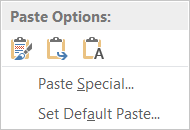
Button Drop-Down - Ctrl Key Result
 |
 |
The first choice (brush) is to keep source formatting.
|
 |
The
arrow button is to merge formatting and the A is to paste the content into
the destination document's formatting. |
 |
Paste Special... brings up a dialog
box that I do not pretend to understand. |
 |
Set Default Paste... let's you
decide what happens when you simply press Ctrl+V to paste.
It gives far more
nuanced control through the Advanced Word Options. |
|
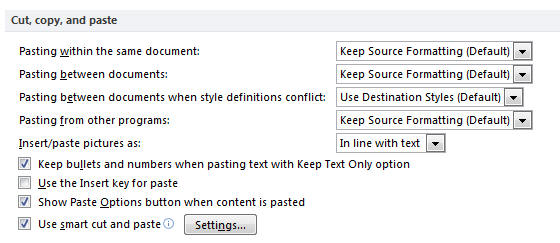
 |
The Cut Button is the mouse equivalent of
Ctrl+X.
 |
It deletes content from the current location and puts it in the Clipboard.
|
 |
Another way of looking at this is that it is the beginning of moving text
(or graphics) from one part of a document to another
(or to a different
document or even program). |
 |
The second step - the new location placement is
done with the Paste command or button.
|
|
 |
The Copy Button also puts selected text or graphics
into the Clipboard. It remains where it is, though.
The keyboard equivalent
for this is Ctrl+C.
|
 |
The Format Painter
(Brush) (Ctrl+Shift+C to copy formatting, Ctrl+Shift+V to
paste formatting)
 |
I strongly urge people to use
Styles rather than the Format
Painter. In the long run it will make your life much simpler. |
 |
Double-clicking on it allows you to paste to different
areas using the mouse brush pointer.
|
|
 |
These all work with the Office Clipboard as well as
the System Clipboard. You can see what is in the Office Clipboard by
clicking
on the dialog launcher in the bottom right corner of the Clipboard
group. (Again, the Mac program does not use Dialog Launchers.)
|
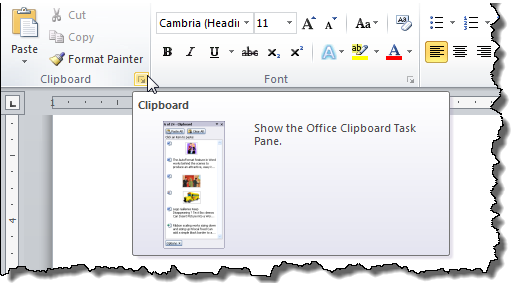
 |
 |
This launches the Office Clipboard Task Pane which shows
items recently added to the Office Clipboard with the latest at the top.
|
 |
The
Office Clipboard can hold 24 items. |
 |
If you Copy or Cut from any program
while an Office program is open, the content is added to the Office
Clipboard as well as to the System Clipboard. |
 |
When you paste content, it
will be from the System Clipboard (which holds one item). |
 |
To use the Office
Clipboard, you need to display the Office Clipboard Task Pane.
|
 |
That pane is
anchored to the left side of the Word window by default but can be made to
float and can be resized when floating. |
|
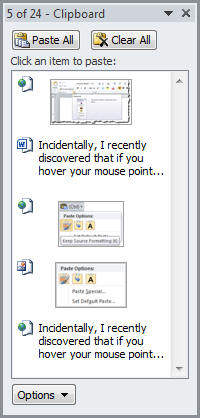
The top of the Office Clipboard Task Pane will tell you the
number of items in the clipboard out of the possible 24. If, with the
Clipboard Task Pane showing, you click on one of the items, it will be
pasted into your document at the current insertion point
even if it was not
the last item placed in the clipboard.
 |
 |
Note that if you Copy or Cut material more than once, it
will occupy multiple postitions in the Office Clipboard. |
 |
Office does not keep track of whether the item is already in the Office Clipboard.
|
 |
The
Clipboard is available in all MS Office programs. |
 |
It is cleared if you close
all Office programs or if you use the Clear option. |
 |
If you use the Clear
option, you will also clear the System Clipboard. |
|
Note, the (Windows) System Clipboard holds the last item
cut or copied. It only holds one item.
Clipboard -- Font
-- Paragraph -- Styles --
Editing -- Voice (2019)
The Font Group

The font group has to do with how characters look. It is
distinguished from the paragraph group where the formatting handles
the
entire paragraph. I am going to divide these controls into three parts:
-
Controls that give you direct formatting or erase that
formatting,
-
A Control that changes the Case of text but is not
formatting, and
-
Controls that change how the text looks but are not
considered formatting.
Let's look at the last two types, first, because there are
only two of them.
Next is the Oops button: Clear Formatting, which will
strip the effects of the other buttons in the font group from selected text.
 |
Clear All Formatting

This says it clears all formatting. This is not accurate. It clears all
direct formatting, the same as using Ctrl+Spacebar and
Ctrl+Q..
It then changes the paragraph style to the Normal style. |
 |
The Clear Formatting button will clear any of the formatting applied by
the remaining buttons in the Font Group or direct paragraph formatting as well as any style
formatting. |
The following are all considered Direct Formatting by Word
and can be cleared by the Clear Formatting button (or by Ctrl+Spacebar).
 |
Font Dropdown and
Font Size Dropdown
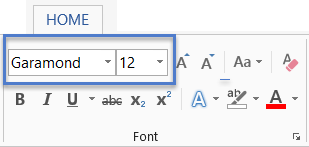
These have been a part of Word since at least Word 97. You can click on
them to give a list to select from or you can type in them.
In the size window you can type a size that is not on the dropdown list.
In the Font window you can start typing the name
of a font and it will
fill in the first font name that fits as you type.
|
 |
Increase Font Size - Grow Font
|
 |
Decrease Font Size - Shrink Font
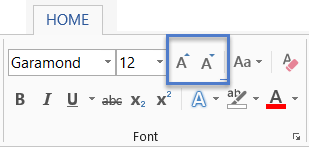
These two buttons will increase/decrease the size of selected text. The
increments are according to the font sizes shown in the
dropdown for
fonts except that for smaller sizes it will go in increments of one that
can be lower than any shown. The minimum is 1.
|
 |
Bold (Ctrl+B) |
 |
Italic (Ctrl+I)
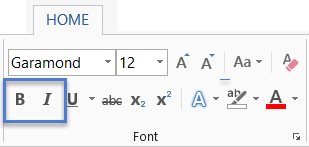
 |
These two buttons apply Bold or Italic
formatting to text. When the insertion point is inside text that has
been
formatted as bold or Italic, these buttons will be shaded.
|
 |
Bold and Italic are toggle formatting. I.e., if you
apply bold to text that is already bold, it is turned off. |
 |
Both can be applied to the same text, so that you
can have text formatted Bold and Italic. |
 |
I tend to use the Strong and Emphasis
character styles instead of the direct formatting in case of a theme
change.
There is no built-in style for that. Applying the style is
not a toggle.
|
|
 |
Underline (with options)
(Ctrl+U)

 |
Clicking on the Underline button will underscore
your text. Clicking the little triangle on the right will give you
options for
the type of underline you want. Once you select an
option, that option is active during your Word session (including in
different documents). The Underline Color brings up a palette. More
Underlines... brings up the Font
dialog box which has
access to even more underline types.
|
 |
You can only apply one type of underlining to a
character. This is character formatting so you could apply different
types to
different characters in the same word. |
 |
If text is already underlined and you click on the
Underline button, the underlining will be removed.
|
|
 |
Strikethrough
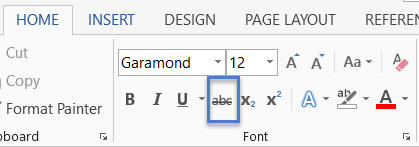
 |
The Strikethrough button gives you a single line
through selected text. A double line is possible through the
Font
Formatting dialog box (below).
|
 |
If this button is clicked on text that already has
double-line strikethrough, it changes it to single-line. |
 |
If it is clicked on text that already has
single-line strikethrough, that is removed. |
 |
The Strikethrough button will be shaded if selected
text has a single underline applied.
|
|
 |
Subscript |
 |
Superscript
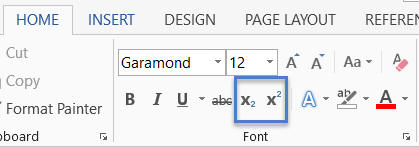
 |
These decrease the font size proportionally and
lower or raise the baseline. |
 |
These buttons are toggles and will be shaded when
text is selected to which they apply.
|
|
 |
Text Effects
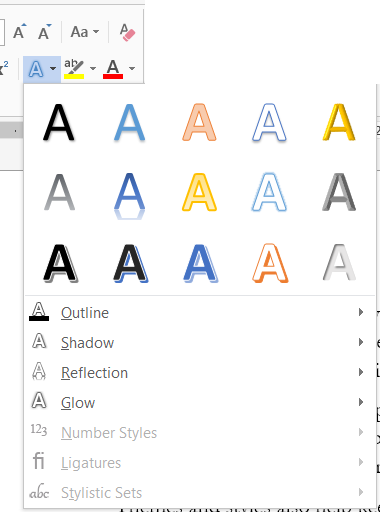
 |
Text Effects lets you apply WordArt type appearance
to text in the body of your document. Unlike WordArt, Text Effects
can be
applied using Styles.
|
 |
The Text Effects button is available beginning with
Word 2010. The screenshot above is from Word 2013; the last three
choices
in the menu are not available in Word 2010. |
 |
This works as a gallery, changing the appearance of
text as you mouse-over a type. |
 |
Also, as you mouse-over, if you pause, you will see
background information on the effect. |
 |
The Text Effects button only works as a drop-down.
Unlike the Underline,
Highlighting, and
Color buttons which also allow choices,
it will not apply an
effect upon being clicked. You need to pick something. |
 |
Text Effects work best on larger-size text. On
body-size text they will make the text unreadable. |
 |
For access to all of the options, you need to use
the Dialog Launcher. |
 |
I do not pretend to understand all of the choices in
this. Here is an
Office-Watch page on them.
|
|
 |
Font Color

 |
If you simply click on the font color button, it
will give you the color shown. That color will be the last one
applied to text in your Word session. |
 |
If you click on the drop-down, it gives you
selections and menu choices. |
 |
I try to use Theme colors when they work. That is
because if a theme is changed, the color is more likely to fit in.
|
 |
More Colors gives you access to the full palette
|
 |
Gradient allows setting multiple colors fading -
this is much more effective with larger text.
|
|
 |
Font Dialog Launcher
(Ctrl+D)
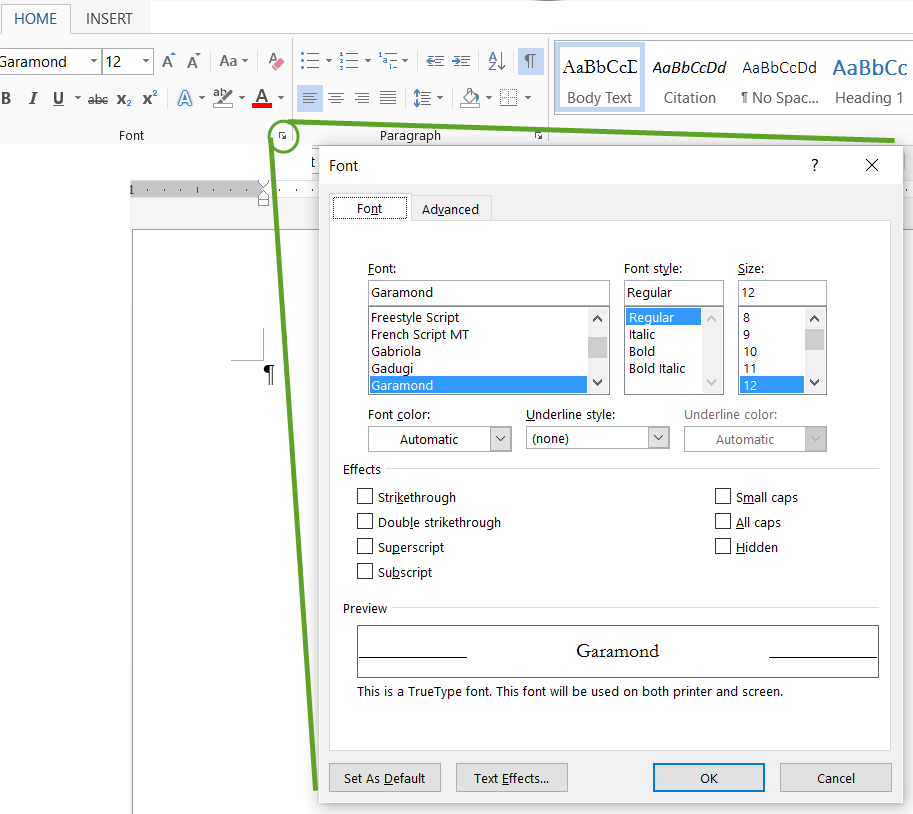
 |
As with many of the Groups on the Ribbon, the Font
Group has a dialog launcher button in the bottom right corner.
|
 |
An alternative for reaching this dialog box is the
keyboard shortcut Ctrl+D. |
 |
This opens a dialog box that gives control over
multiple options and gives more options than do the buttons on the
Ribbon. |
 |
Two not available on the Ribbon buttons are Double
strikethrough, and SMALL CAPS.
In addition, the Underline style gives
access to many different
kinds of underscores. |
 |
The Preview box at the bottom previews what you are
setting. |
 |
Under that are buttons that let you set these
settings as the default for new documents (based on this template),
for text effects, and OK/Cancel. |
 |
Even more options are available on the Advanced tab
of the font dialog box: |
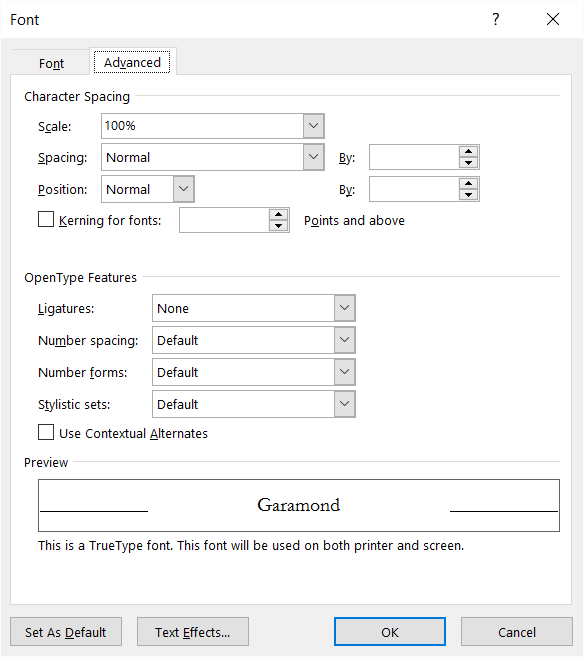
 |
These have to do with character rather than line
spacing. |
 |
Exploration of these options is beyond the scope of
this page. |
|
Clipboard -- Font
-- Paragraph -- Styles --
Editing -- Voice (2019)
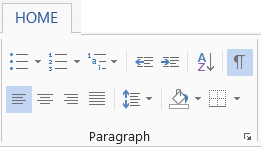
Bullets and Numbering is the top-right
section of the paragraph group.

For simple documents that will not need much editing,
these will work fine.
 |
Bullets |
The first button is for bullets. Clicking on the
bullet button will give you a bullet, the type of bullet will be the
last type used by you. Following paragraphs will have the same
bullet type. When you press the Enter key to create a new paragraph
in an empty line, Word will discontinue use of bullets. When you
click on the button, Word changes the indents to add a "hanging
indent" that indents both the bullet and the associated text.
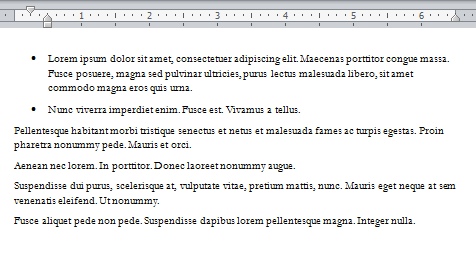
Clicking on the down-pointing triangle will give you
choices.
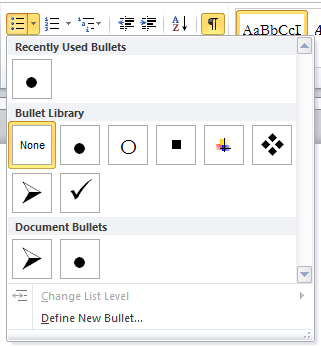
You can also choose to define your own bullet icon.
For documents that are going to be heavily edited or
with multiple kinds of bullets, I recommend use of bullets linked to
Styles. See
How to control bullets in Ribbon Versions of Word by Shauna Kelly.
 |
List Numbering |
The second bullet is for simple numbered lists.
Clicking on the button will give you a single-level numbered list of
the type last used. Shown below is such a number inserted with the
ruler showing.
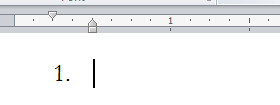
Included with the numbering is a first-line indent
and a hanging indent. Your numbered list will be set in from the
margin and following lines in the paragraph will be set in more.
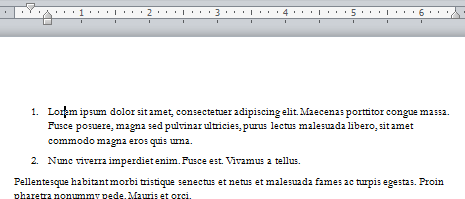
As with bullets, you can apply this to existing
paragraphs.
As with bullets, the down-facing triangle will give
you more choices.

The screenshot above shows the gallery of choices.
As with the bullets gallery, the list number gallery lets you
preview your choice for selected text. In this show, the current
choice is with the full stop following the number; the previewed
choice is with a right parenthesis. As with bullets, you can define
a new format. In addition, you can reset or restart your numbering.
Again, with simple documents that will not be edited
much, this button works fine. For anything more complex, you will
want to go to Numbering linked to Styles. See
How to create numbered headings or outline numbering in Ribbon
Versions of Word by Shauna Kelly. This method gives much finer
control and is much less prone to development of "spaghetti
numbering."
If any East-Asian language is enabled, the Paragraph
Group on the Home tab will include two additional controls to change
the text direction. When used with a non-East-Asian language, they
do not really change the direction but do change the ruler and other
things. This is explored more in
my page on Alignment and Justification.

The little arrow in the bottom right corner of the
Paragraph group launches the Paragraph Formatting dialog. Again,
such formatting is best done using Styles rather than directly.

Clipboard -- Font
-- Paragraph -- Styles --
Editing -- Voice (2019)

The Styles Group in Word 2007-2010 is shown above. The
Styles Group for 2013 and later no longer has the Change Styles dropdown.
That has been moved to the design tab in those versions.
From Word 2016 on it has become smaller horizontally but still has the
expansion dropdown menu.

With Word 2021 and Windows 11, a different look was
introduced, called the "New Experience."
It changed the Styles Group, removing the unformatted names of the styles
and instead showing them formatted.
This decreases the number of styles that can be displayed.

That change was reversed in late 2024.
However, Update 2412 changed the arrows at the right end of the [Quick]
Styles Gallery. This changes more recent versions.
There is now a single arrow that expands the Gallery.
It is possible to add style controls to the Quick Access
Toolbar. Here is a link to my free Add-In that does this:
Styles QAT Add-In.
Clipboard -- Font
-- Paragraph -- Styles --
Editing -- Voice (2019)
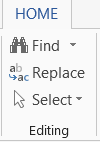
The Editing Group actually appears on the far right end of the
Home Tab.
The Editing Group has three choices, two of which are
drop-down.
 |
Find

 |
Find (Ctrl+F) opens the navigation pane with
the insertion point in a search box |
 |
Advanced Find (Ctrl+H, Alt+D) opens the
Find dialog box (See Replace below) |
 |
Go To... (Ctrl+G) opens a dialog that lets you go to
a point in your document
|
|
 |
Replace (Ctrl+H) opens the
Replace dialog box shown below.
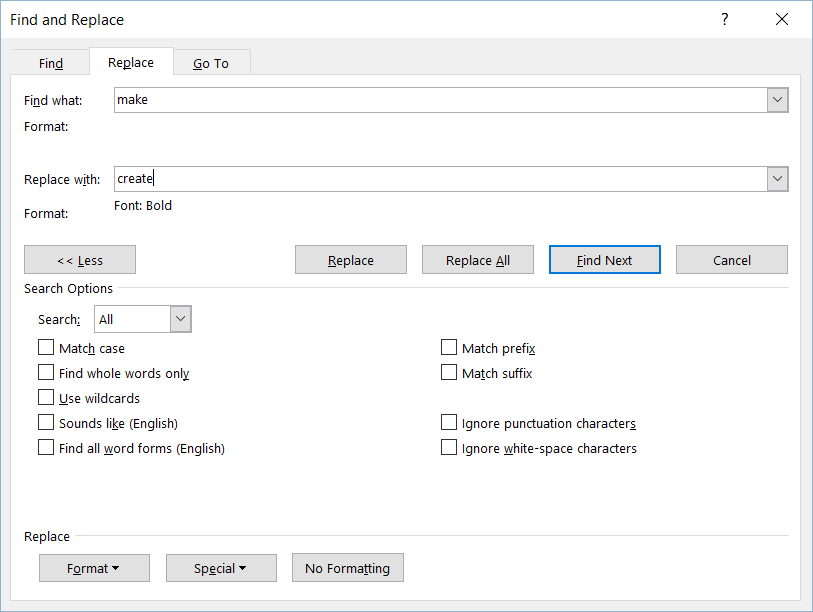
 |
Actually, it opens a smaller dialog box with everything
above "Search Options" on it. In the smaller version the
button on the left reads "More >>" instead of "<< Less." |
 |
Note the Find and Go To tabs at the top. These are the dialog
boxes for the Advanced Find and Go To commands. |
 |
The Replace dialog can be used instead of the Advanced Find box
if you want, just ignore the Replace and Replace All buttons. |
 |
Under both the Find what and Replace with boxes are areas for
format. These are controlled by the Format and
No Formatting buttons when the cursor is in the box for the text. |
 |
There are multiple web pages devoted to this dialog box. Here is
a place to start: MVP General
Word Help Page |
|
The Voice Group - Dictate Office 2019-2024/365
Only

Note that the
Online version of Word also has a Transcribe function.
As far as I know, this is the only function available in the Online version
that is not in the Desktop applications.
This page has been exploring the controls in Word 2010 and
2013. The Home tab has remained mostly the same in all versions of Word.
Here are some screenshots.
Word 2007

-Word 2007 - wider

-Word 2007 - narrower

The three tabs above are all
screenshots of the ribbon on the same computer. Word repackages the ribbon
tabs to fit the available space. Here, I've simply decreased the size of the
screenshots of the wider versions.
In the wider version, it gives more space to the Styles
Gallery. In the narrower version some buttons shrink or lose captions. The
combination of screen size and resolution determines what you will see,
so your ribbons may not look exactly like any of the ones shown here.
Another example showing different screen layouts is in the Word 2010 version
of the Drawing Tools contextual tab below. Your ribbon may or may
not have a Developer Tab,
that is up to you.
The Word 2007 and 2010 tabs shown are from a laptop running
Windows Vista. The Word 2013 tabs are from a desktop tower running Windows 7
on a larger screen.
Word 2010

Word 2010 - Narrower

(Note the collapse of the QuickStyles Gallery and Editing Group. The Quick
Styles gallery is now available through the dialog launcher button next to
the word "Styles.". Other groups are
compressed. This is less than half as wide as the one immediately
above it.)
Word 2013

Word 2016/365
Original Word 2016

Word 2016/365 in 2018 - Note Voice/Dictate Group on Right

Word 2019/2021/365 in 2023

Word 2021/365 New Experience applied in 2023 - major change is look of Quick
Styles Gallery and addition of Editor


Changes / suggestions / ideas can be sent to
Charles
Kenyon.

This page viewed
 times since 14 April 2004.
times since 14 April 2004.
|